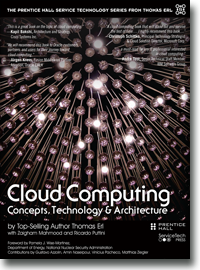Cloud Computing Patterns, Mechanisms > Basics > Data Center Technology > Network Hardware
Network Hardware
Data centers require extensive network hardware in order to enable multiple levels of connectivity. For a simplified version of networking infrastructure, the data center is broken down into five network subsystems, followed by a summary of the most common elements used for their implementation.
Carrier and External Networks Interconnection
A subsystem related to the internetworking infrastructure, this interconnection is usually comprised of backbone routers that provide routing between external WAN connections and the data center’s LAN, as well as perimeter network security devices such as firewalls and VPN gateways.
Web-Tier Load Balancing and Acceleration
This subsystem comprises Web acceleration devices, such as XML pre-processors, encryption/decryption appliances, and layer 7 switching devices that perform content-aware routing.
LAN Fabric
The LAN fabric constitutes the internal LAN and provides high-performance and redundant connectivity for all of the data center’s network-enabled IT resources. It is often implemented with multiple network switches that facilitate network communications and operate at speeds of up to ten gigabits per second. These advanced network switches can also perform several virtualization functions, such as LAN segregation into VLANs, link aggregation, controlled routing between networks, load balancing, and failover.
SAN Fabric
Related to the implementation of storage area networks (SANs) that provide connectivity between servers and storage systems, the SAN fabric is usually implemented with Fibre Channel (FC), Fibre Channel over Ethernet (FCoE), and InfiniBand network switches.
NAS Gateways
This subsystem supplies attachment points for NAS-based storage devices and implements protocol conversion hardware that facilitates data transmission between SAN and NAS devices.
Data center network technologies have operational requirements for scalability and high availability that are fulfilled by employing redundant and/or fault-tolerant configurations. These five network subsystems improve data center redundancy and reliability to ensure that they have enough IT resources to maintain a certain level of service even in the face of multiple failures.
Ultra high-speed network optical links can be used to aggregate individual gigabit-persecond channels into single optical fibers using multiplexing technologies like dense wavelength-division multiplexing (DWDM). Spread over multiple locations and used to interconnect server farms, storage systems, and replicated data centers, optical links improve transfer speeds and resiliency.
